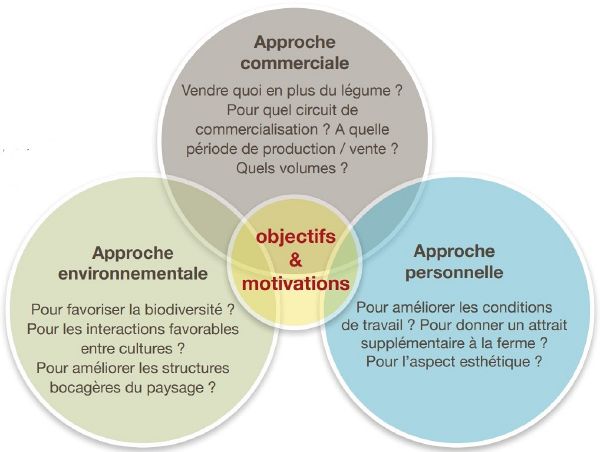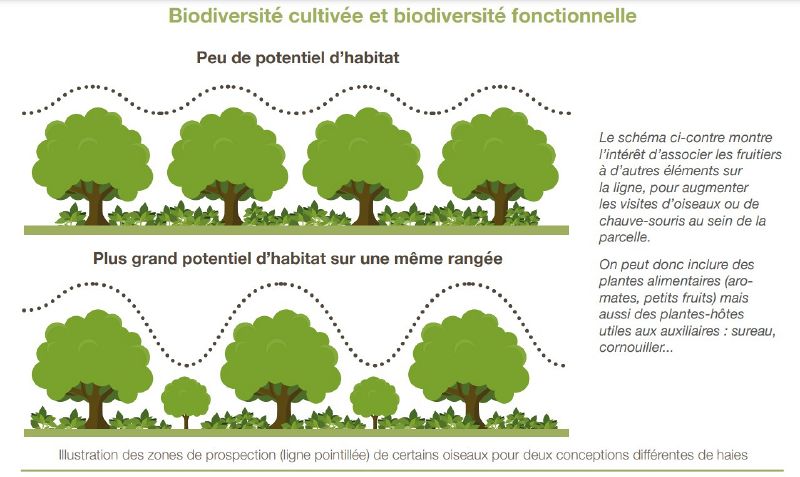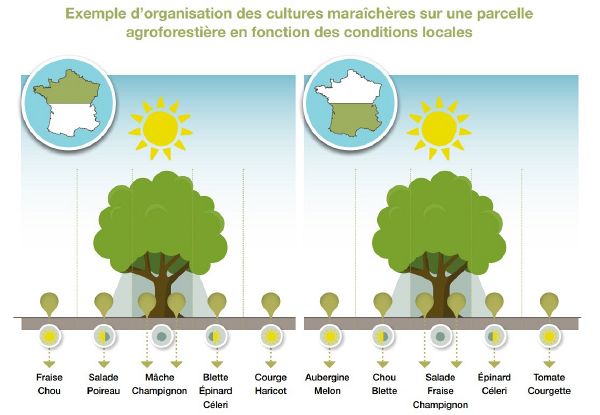Choosing which tree species to plant in agroforestry
 Maple, Elm, Willow, Alder, Oak, Ash, Hornbeam...
Maple, Elm, Willow, Alder, Oak, Ash, Hornbeam...

L'agroforestry is a system that can be envisaged for many types of production, and the combinations of species that can be combined are infinite. However, soil and climate conditions, the farmer's motivations and objectives, and the existing sectors limit the choice of species to be planted. To create a well thought-out system, you need to start by asking yourself the right questions.
In this article, you'll first find an approach to help you identify the needs of your agroforestry project, followed by a number of resources describing the characteristics of different tree species.
You'll find a list oftree species here.
How do I choose the right tree species for my project ?
First step : Soil and climate conditions
- It's a good idea to start by carrying out a soil diagnosis of each plot using a 1 or 2 m soil profile. Different tree species are sensitive to soil structure, texture,waterlogging, drainage and pH. For example, wild cherry, ash and walnut do not do well in hydromorphic soils.[1].
- The climate must also be taken into account : temperature, rainfall, risk of summer drought, winter frosts or late frosts. Care must be taken on this point, as the trees will potentially be planted for 15 to 100 years, and the climate is bound to change over this period, to a greater or lesser extent depending on the region.
- For each plot, take into accountexposure to sun, wind, slope andaltitude.[2] A hazel tree, for example, can grow up to 4m high on the plains and only 1.5m high in the mountains.[3].
To ensure that tree species adapt well to soil and climate conditions, it is often advisable to choose species and varieties that occur naturally in the surrounding landscape. This also helps to preserve the identity of the region. It is possible to obtain certified "local" plants.
Second stage : my project, my motivations, my objectives
- L'French Agroforestry Association identifies the different agroforestry systems as follows :
The most suitable system will depend in particular on the crops already grown on the farm, except in the case of a start-up.
- What are the reasons behind my project ? To diversify and stabilise my income through new production (fruit, wood, mushrooms, etc.), to create a more favourable microclimate, to combat pests, to promote biodiversity, aesthetic aspects, etc. Each species of tree has different qualities, and is therefore more or less suited to your objectives. Some produce fruit, others resist the wind well and act as a barrier against it, or are naturally insect repellent, while others are highly melliferous and attract a lot of wildlife.

- How can I organise my trees to meet my objectives ? In the form of a hedge, isolated or aligned trees in the plots, a garden forest, etc. The spatial organisation of the agroforestry plot is important for its functioning. Choosing trees of different heights (which depends on thespecies, choice of rootstock and pruning method in particular) helps to create a tiered, diversified ecosystem. It will therefore often be more resilientand offer more services. But you need to combine species that grow well together and not against each other (competition for sunlight, for roots, etc.). You can also combine species that start to produce more or less quickly, to earn an income from the trees in the first few years.

- Which species are compatible with my other crops or animals ?Competition between different levels of vegetation for light and soil resources is an important factor in choosing species and varieties.Nitrogen-fixing trees compete less with other crops for this nutrient, and if they are sufficiently dense they can even enrich the soil. But these are not the only points to bear in mind : for example, in silvopastoralism, care must be taken to ensure that the leaves and fruit are not toxic to animals (sensitivity of cattle, horses and goats to apples and acorns, etc.).[4]), and that there are no thorns on the trunk or branches. For mushroom production, we know that there are preferential associations between species of mushroom and trees.

- Which species are compatible with my system in terms of workload ? You need to ask yourself how much time you can devote to trees, and choose species that meet your needs. A well thought-out system that takes into account the pollination and ripening periods for each species ensures that work peaks are spread out over the year, and therefore allows market gardeners to alternate between fruit and vegetables and have production to sell 10 to 11 months a year in the South and 6 to 7 months a year in the North of France.[5]. Be careful to adapt the number of species, as a complex system is likely to be too time-consuming.
Third stage : Outlets and marketing methods
The choice of species and varieties, as well as their number, depends on the marketing channels envisaged.
- First of all, you need to check that there is a market for the products, or that direct sales are possible, and assess the interest of potential customers in the planned production over a number of years. Whether it's wood or fruit, marketing often doesn't start until 10 to 15 years after the farm has been established.
- If on-farm processing (of fruit, for example) is a primary objective : choose varieties that are suitable for crunching, cooking, juicing, etc.
- Find out about the requirements of the sector or the specifications of a contract (PDO for example).
- Direct sales or short circuits : Advantages of numerous species and varieties (consumer choice, spread of supply over time and climatic resilience).
- Wholesale or semi-wholesale : Advantage of a reduced number of species and varieties (to achieve the required volumes and quality).[5].
Other points to bear in mind when choosing species
- Risk of rejection and suckering with Robinia.[6] for example.
- Forest grazing regulations : Prohibited for 10 years after a fire(Art. 322-10 of the Forestry Code), subject to authorisation in a protection forest (Art. 412-13 of the Forestry Code).
- CAP : The eligibility criterion for basic CAP payments of <100 trees/ha only applies to forest species, not to fruit trees. Some trees, such as chestnuts, may be considered to be fruit trees if the fruit is harvested.
- Equipment required and available.
- Training and advice available.
Resources
Sources
- COULON F., POINTEREAU P., (consulted on 12/08/2022) Concevoir son pré-verger et valoriser ses fruits, Solagro, online : https://www.agroforesterie.fr/wp-content/uploads/2022/07/concevoir-son-pre-verger-et-valoriser-ses-fruits-brochure-solagro-.pdf
- https://www.agroforesterie.fr/
- https://www.agroforesterie.fr/wp-content/uploads/2022/07/plaquette-arbres-haies-et-bandes-vegetalisees-dans-la-pac-2015-2023.pdf
- ↑ Refining your agroforestry project : choosing species and planting; InPACT 37, based on a presentation by Patrice Boiron on 6 and 8 September 2010. http://www.inpact37.org/images/Fiche_technique_-_Affiner_son_projet_de_culture_en_agroforesterie-_choix_des_essences_et_plantation.pdf
- ↑ Parc Naturel Régional de Lorraine, Fiche haies, 22/10/2010 https://afac-agroforesteries.fr/wp-content/uploads/2015/10/fiches-haies_1393511427-2.pdf
- ↑ Ambroise R., Boutaud M., Canet A., et al. (2009) Guide technique PAGESA (Principes d'Aménagement et de Gestion des Systèmes Agroforestiers), Association Française Arbres et Haies Champêtres (AFAHC)https://www.agroforesterie.fr/wp-content/uploads/2022/07/pagesa.pdf
- ↑ Le pré-verger (consulted on 12/08/2022), Agroforesterie Association Française https://www.agroforesterie.fr/pre-verger/
- ↑ 5.0 5.1 Warlop F., Corroyer N., Denis A., Conseil M., Fourrié L., Duha G., Buchmann C., Lafon A., Servan G., 2017. Combining vegetables and fruit trees in agroforestry : Principles, technical elements and points to watch for to design and manage one's plot. SMART project. 40 p. June 2017 https://www.agroforesterie.fr/wp-content/uploads/2022/07/guidevergermaraichersmart.pdf
- ↑ Agroforestry : some tree species, based on François de Soos' talk at a " Sol en vie " training day,(01/09/2012) https://www.journees-paysannes.org/Agroforesterie-quelques-essences-d-arbres.html
Appendices and links
Est complémentaire des leviers